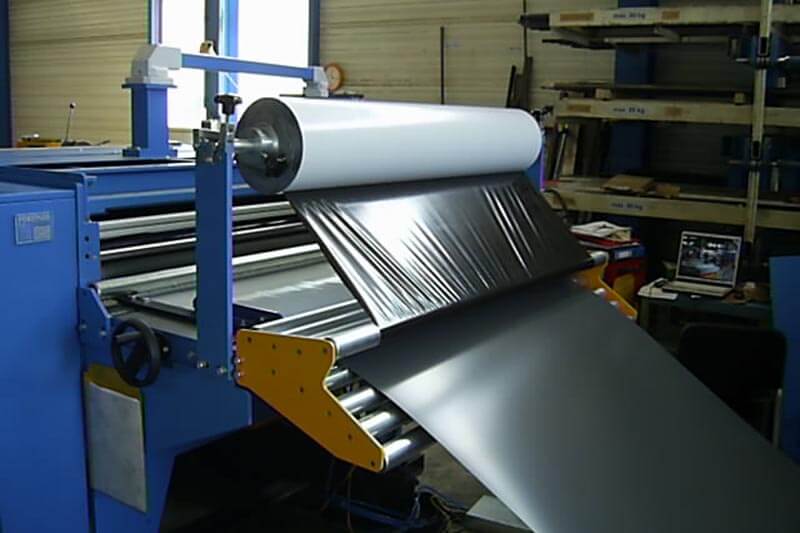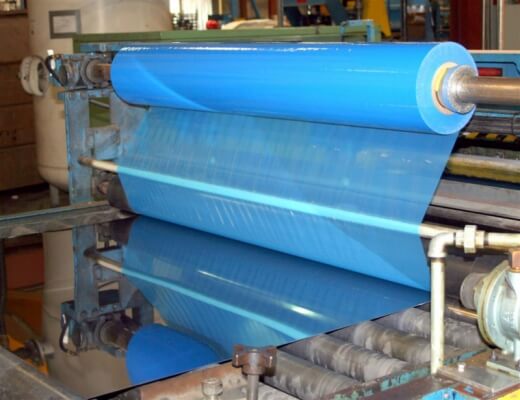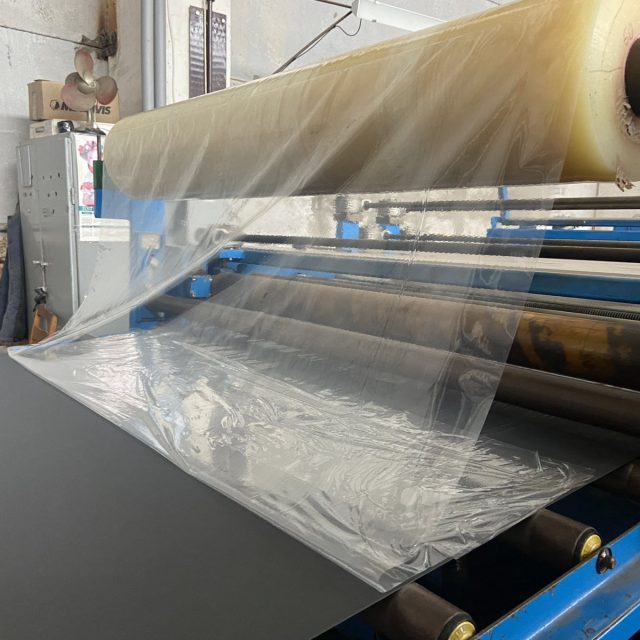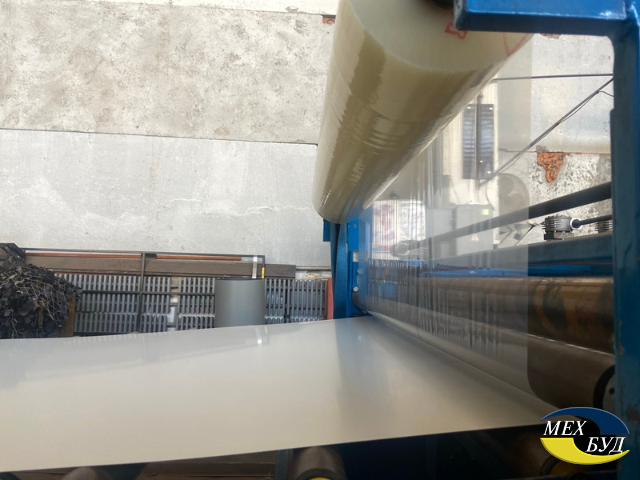Film for Metal: How to Protect the Finished Product?

The main threat to shaped products made of thin-sheet metal (from corrugated sheets to metal cassettes and panels for enclosing structures) is corrosion processes that develop when the steel or aluminum base comes into contact with oxygen. Metal is protected from corrosion in various ways, with the most common methods being galvanization and applying powder coating or a protective-decorative polymer coating on the galvanized surface.
However, even in this case, the risk of corrosion doesn’t completely disappear. This is because during manufacturing, storage, loading, or installation, the integrity of the protective layer can be compromised. It’s usually in these vulnerable spots that metal begins to rust, which negatively affects the strength and durability of the entire product.
To prevent damage to the protective coating, various materials can be used, but the most practical and affordable solution is a thin polymer film.
Purpose of Protective Film
Protective film is made from PVC or polyethylene with a thickness ranging from 30 to 60 microns. Typically, even the minimum thickness is sufficient to prevent accidental damage to products during handling.

For ease of installation and to ensure product safety, acrylic adhesive is applied to the back of the film (different film brands may vary in adhesive strength).
Protective films are used for the protection of the following materials:
- Galvanized steel
- Stainless steel
- Nickel-plated/chrome-plated steel
- Galvanized steel with powder or other polymer coatings
- Anodized aluminum
- Aluminum with powder or polymer coatings

The protective film coating can be applied to both blanks (strip, sheet) and finished products after forming or other processing. Generally, film packaging is done at the final stages of the production cycle, just before being sent to storage.

Main Functions of Film Coating:
- Protection of polymer or zinc coatings from damage and other influences during product storage
- Protection from mechanical damage during loading and transportation
- Preservation of the integrity of the part during installation
Additionally, if finishing work (such as puttying or painting) is expected after product installation, the film can be left on for an extended period. This protects the surface from contamination: instead of scrubbing paint stains off the coated metal, you can simply remove the polyethylene layer.
Important Parameters of Protective Films
Many companies produce protective films for metal, but it’s important to note that different brands of films can significantly vary in performance characteristics.

What should be considered?
- The first parameter is the thickness of the film. The thicker the material, the more expensive it is, but the more reliable the protection for the metal coating.
- Next is the film’s resistance to external factors. Most polymer films lose their elasticity and deteriorate under UV radiation. Using materials resistant to ultraviolet rays enhances the reliability of product protection, especially if it is stored outdoors (which is undesirable), or remains under the film for some time after installation.
- It is also important to consider the quality of the adhesive. Here, it’s not just about adhesion, but also about maintaining adhesive properties over time. A high-quality adhesive keeps the film on the metal for a long time, but doesn’t adhere “permanently” and leaves minimal residue after the film is removed.
Other important parameters include the absence of volatile toxins in the film composition (safety for humans) and heavy metals (an important factor for environmentally safe disposal).

Protective film for metal helps preserve both the zinc layer and polymer coatings intact. The use of such films is one of the indicators of production culture for shaped thin-sheet products, which is why companies that care about product quality are very selective when choosing protective polymer coatings.
How to apply the film to metal?
There are different methods for applying protective films to metal, depending on the type of film and production conditions. The most common methods for applying films to metal are:
- Manual application: The film is applied to the metal surface manually using a roller, brush, or spray.
- Mechanical application: The film is applied to the metal surface using mechanical devices such as rollers, calenders, or laminators.
- Thermal application: The film is applied to the metal surface using a thermal process, such as heat shrinkage or thermoforming.
- Electrostatic application: The film is applied to the metal surface using an electrostatic field, which attracts the film to the metal surface.
Each of these methods has its advantages and disadvantages and may be most effective depending on the type of film and production conditions. For example, manual application may be most suitable for small-scale production, while mechanical or thermal application may be more effective for large-scale production.

Mistakes when applying the film
When applying protective film to metal, various mistakes can occur, which can affect the quality of protection and the lifespan of the coating. Here are some of the most common mistakes and tips on how to avoid them:
- Insufficient surface cleaning
Applying the film to a dirty or dusty surface can lead to bubbles, unevenness, and poor adhesion. Dirt or grease stains under the film weaken the protection and spoil the appearance of the product.
Tip: Before applying the film, thoroughly clean the metal surface, remove dust, dirt, and degrease with special agents.
- Incorrect film alignment
If the film is applied crookedly or with wrinkles, it will not only ruin the appearance but also reduce the protective properties of the coating. Wrinkles can become points of moisture and contamination penetration.
Tip: Carefully and slowly apply the film, gradually smoothing it from one end to the other to avoid shifting and wrinkles.
- Failure to follow the temperature regime
Applying the film at too high or low temperatures can affect its adhesion and durability. At low temperatures, the film may not adhere properly, and at high temperatures, it may stretch and deform.
Tip: Apply the film at the optimal temperature specified by the manufacturer to ensure better adhesion.
- Neglecting expiration dates and film quality
Using expired or low-quality film can result in the coating breaking down quickly and no longer performing its protective functions.
Tip: Check the quality and expiration date of the film before use. Choose films from trusted manufacturers.
- Incorrect removal of the protective layer of the film
Some types of films have a protective layer that needs to be properly removed before application. Improper removal can damage the adhesive layer and reduce adhesion.
Tip: Follow the manufacturer’s instructions for removing the protective layer if necessary.

Types of Protective Films for Metal
There are several types of protective films for metal, each suitable for different conditions and purposes. Let’s look at some of them:
- Polyethylene Film
This is the most common type of protective film used to protect metal from scratches, dust, dirt, and other surface damage. Polyethylene film is easy to install and remove and can be used on a wide range of metal surfaces. - Polyurethane Film
This type of film is typically used to protect metal surfaces from heavy damage, such as chips, scratches, and impacts. Polyurethane film is stronger and more durable than polyethylene film and can be used on a broader range of metal surfaces. - Polymer-Based Film
This type of film is designed to protect metal from corrosion and other chemical effects. Polymer-based films are applicable on various metal surfaces, including aluminum, stainless steel, and titanium. - Rubber-Based Film
This type of film is commonly used to protect metal surfaces from the effects of water, oils, and other liquids. Rubber-based film can be applied to a wide range of metal surfaces, including aluminum, stainless steel, iron, and copper.
Additionally, there are specialized films designed for specific types of metal and certain conditions, such as films for protection from the sun and ultraviolet rays, or films for protection from radiation, etc.
